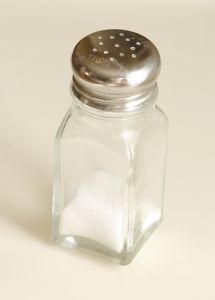 My father used to tease that at my mother’s family gatherings everyone was given their own salt shaker with their flatware. At family gatherings on both sides I have heard suggestions of adding salt to apples, watermelon, cottage cheese, and pumpkin pie. I am not a pumpkin pie fan, but admittedly, it did seem to make it taste more sweet. Thus I wasn’t all that surprised to read this article in the New York Times.
My father used to tease that at my mother’s family gatherings everyone was given their own salt shaker with their flatware. At family gatherings on both sides I have heard suggestions of adding salt to apples, watermelon, cottage cheese, and pumpkin pie. I am not a pumpkin pie fan, but admittedly, it did seem to make it taste more sweet. Thus I wasn’t all that surprised to read this article in the New York Times.
Government health officials, the Institute of Medicine, and Michelle Obama are all urging food companies to greatly reduce their use of salt, in hopes of saving thousands of American lives each year. I should not have been surprised to read that processed foods account for 80 percent of the salt in the American diet.
It did not surprise me that salt (or the lack thereof) makes a dramatic difference in some of the most familiar processed foods. Michael Moss writes,
Beyond its own taste, salt also masks bitter flavors and counters a side effect of processed food production called “warmed-over flavor,” which, the scientists said, can make meat taste like “cardboard” or “damp dog hair.”
Without salt, the popular Cheez-It changed colors, lost its crunchiness, and tasted of medicine. Corn Flakes were said to taste metallic without salt. Stale straw was the description given to the taste of Eggo waffles without salt. Apparently, the only butter flavor in Keebler Light Buttery Crackers comes from salt. It was only mildly surprising to learn that some processed foods contain up to 10 salt or sodium compound ingredients in a single food.
It is not all that surprising that the food companies are fighting back against this campaign. Not only is salt effective in improving taste and preserving food, but it is also cost-efficient. Slicing the salt in food products will require creativity and more cost to food companies. Food companies are concerned that they may have to charge more for their products or, if they do not find the right flavor balance, customers will be disappointed with a change in taste. Food companies are arguing that people will not buy and the market will not support food products without salt. Consumers seem to be less motivated by their health than by losing weight, and thus more willing to accept a change in flavor for reduced calorie foods.
The many ways that the food companies are fighting back and trying to downplay the dangers of a high-sodium diet probably should not be surprising to me. Rather than spending money on researching healthier flavorful options, food companies are funding research to distract from the dangers of salt and lobbying efforts to prevent new legislation and regulations. One line I really liked from the New York Times article is “Food companies say that reducing salt by 10 percent or so is easy, but that going further is difficult.”
Instead of making the changes they can in order to keep their loyal customers alive, food companies seem to be fighting any change to their formulas. Although not the optimal solution, how much would our health improve with just a 10 percent reduction in salt?
